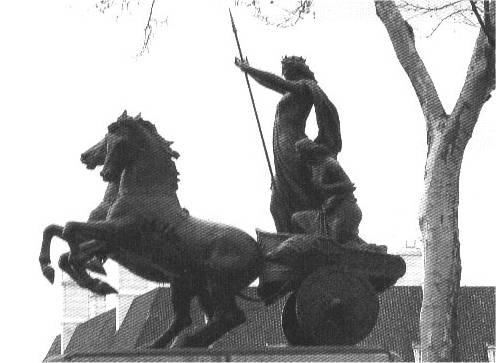
Since approximately 42 AD, Britain, garrisoned by about 30,000 Roman soldiers was the scene of recurring independent uprisings of individual tribes. The tribal allegiance was more akin to families and clans than to any sort of national unity. These uprisings continued sporadically up to AD 60, the time of Boudica, Warrior Queen.
In AD 60 Suetonius Paullinus, governor of Britain, and commander of the legions there, was at the Isle of Mona in the north on a campaign to destroy the Druids, fomenters of many of the tribal uprisings. He was determined to end their influence.
In the south, in the area today called East Anglia, the Iceni tribe, with King Prasutagus and his wife Boudica flourished as an established ally of Rome. The women of the British tribes had a centuries old history of leadership in government and in war. To the south of the Iceni tribe were the Trinovantes.
In AD 60 king Prasutagus died, and in his will he designated the Emperor Nero as co-heir with his two daughters, hoping to continue harmonious relations with Rome. However, the Roman procurator in Londinium, Catus Decianus did not honor this will and ordered his kingdom plundered. All the chief men of the Iceni were stripped of their ancestral possession, and all the kingís relatives were made slaves. To add to this indignity Queen Boudica, was herself publicly flogged by Roman soldiers and her daughters were taken off and raped.
United by common concern and hatred the neighboring Trinovantes tribe joined in revolt. Camulodunum, a Roman colony, was located in the territory of the Trivovantes, and they had suffered much at the hands of the Romans. They had land and personal property confiscated, and some were enslaved. The breaking straw was the flogging of a royal Celtic queen, and the rape of her two daughters. They were incited to revolt.Suetonius, in the north 350 miles away, heard of the uprising by dispatch. Noting that the uprising was led by a woman, Queen Boudica, he did not realize the gravity, and he did not yet learn of the loss of the 2,000 of the ninth legion. He took a small force and hurried on to Londinium, which he correctly assessed as the next likely target of this primitive, barbarian, swarm, led by a ìwoman.î
The tribes, their numbers swelled by additions along the march to well over 100,000 strong, (some historians record the number as much as 230,000)and swarmed toward Camulodunum, a model of the Roman presence in Britain. They swarmed like a multitude of locust across the land. The ninth Roman legion was called to help, and 2,000 soldiers were destroyed by the swarm of Celts. This too was the fate of 200 soldiers sent by Catus Decianus from Londinium, the only troops at hand. Catus then fled to Gaul.
The Iceni and the Trinovantes laid utter waste to Camulodunum, killing all, men, women, and children, plundering anything of value, and reducing by flames all the buildings, including the temple to Claudius, along with all those who took refuge inside. It was a terrible and hideous slaughter.
Arriving in Londinium he sought out Catus Decianus, and found that he had fled to Gaul. He further find out that the ninth legion has been decimated, all but a handful of the 2,000, plus the 200 sent from Londinium, and there is nothing but scorched earth left at Camulodunum. He realized that he could do nothing with his small force against such numbers, and returned to rejoin the 14th legion and part of the 20th, 10,000 strong in all. He also sent for the second legion under Poenius Postumus. He would take a stand with these forces.
Poenius Postumus did not send help. Suetonius picked a site for engagement of battle best suited to his strategy of war, and to effectively utilize the superiority of Roman tactics and training.
The last part of this History Channel special depicts the final battle. How one Roman legion of 10,000 defeated a fierce Celtic force of over 50,000.
This is a remarkable adventure story and it's all true. The revolt failed. Britain was once again subject to reprisals after the revolt.
Page 12 ~ THE POMPEII EXHIBITION